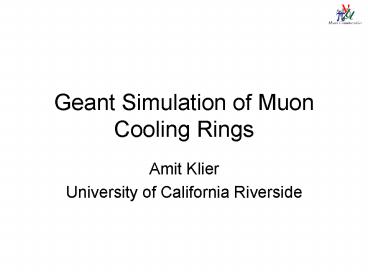Geant Simulation of Muon Cooling Rings PowerPoint PPT Presentation
1 / 24
Title: Geant Simulation of Muon Cooling Rings
1
Geant Simulation of Muon Cooling Rings
- Amit Klier
- University of California Riverside
2
Outline
- A short reminder from Nufact03
- The RFOFO ring
- Geometry
- Software improvements
- Simulation results
- The small dipole ring
- Geometry
- Software improvements
- Some Results
3
Muc_Geant
- Modified, data-driven Geant3 application for
simulating muon cooling - Electric fields added
- Runge-Kutta changed to include changing electric
fields (eg RF cavities) - Realistic magnetic fields can be read from
external field maps
4
From Nuact03
Tetra ring simulated
Rajendran Raja Nufact 03
5
The RFOFO ring
- A few code changes w.r.t. Tetra
- Realistic magnetic field maps read-in (R.
Godang, S. Bracker MC-Note 271)
6
The RFOFO ring
Full Geant simulation A. Klier MC-Note 298
7
The ring geometry
- 33 m circumference
- 12 cells (2.75m)
- A wedge absorber
- opening angle 110,
- pointing upwards
- 6 RF cavities
- 28.75 cm long,
- iris radius 25 cm
- flat E field in z direction
- 2 tilted solenoids
- inner/outer r 77/88 cm
- tilt angle 3
- Only for display here
8
Closed orbits in a single cell
Solid line the reference orbit
200 MeV
270 MeV
227 MeV
250 MeV
250 MeV
227 MeV
E 200 MeV
E 270 MeV
9
Software improvements
- ICOOL input/output format used, ecalc9 can be
used to calculate emittance - Use initial time of particle at entry
- Use virtual detectors
10
Cooling of a muon beam
11
Comparison with ICOOL
Transmission
6-D emittance
12
More comparisons
Results after 10 turns
Merit factor
Trans. W/O decay Trans. With decay Merit Factor
Balbekov (MC-264) 70 56 55
ICOOL (Fernow) -- 58 66
Geant 72 57 70
13
Change beam entry angle
14
The small dipole ring
Weak (edge) focusing (ideally) scaling Filled
with 10 Atm. hydrogen gas _at_ 77K
Dipole field 2 T
For P?200 MeV/c, the radius should be 60 cm
15
Field map (from S. Kahn)
By in a single quadrant
By at R60 cm
Return yoke
16
Reference orbit
- Scale B down to 90
- closed orbit
- P171.25 MeV/c
- Rmin56.32 cm
- (x0 in virtual detectors)
Rmin
RF cavity (active region)
Virtual detector plane
17
Ellipses
Stable up to y13 cm
Y plane symmetry imposed
18
Acceptance of the ring
A blob
Py19 MeV/c
y8.5 cm
Px34 MeV/c
More natural decrease with no x-z plane
symmetry
x6.5 cm
19
Cooling with no scattering
Xinitial6 cm
Yinitial8 cm
tinitial 1.5 ns
Xcentral0.04 cm
Ycentral0 cm
tcentral0 ns
PXinitial30 MeV/c
PYinitial17.5 MeV/c
Einitial213 MeV
PXcentral0.12 MeV/c
PYcentral0 MeV/c
Ecentral201.8 MeV
20
Software improvements
- More flexibility less hard-coding, more
external parameters - Field map reading code used to be RFOFO-specific,
now more general - More RF parameters
- Cavities in small dipole ring are off-center
- So far, only perfect pillbox (or flat field..)
cavity are simulated - Flexibility different frequencies, gradients,
types can be used in the same channel
21
To do
- Simulate the small dipole ring with a beam
- Introduce more realistic features
- Injection
- Detectors
22
(No Transcript)
23
Additional Slides
24
Comparison with ICOOL
Transverse emittance
Longitudinal emittance

